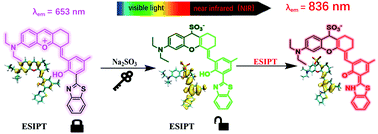An ESIPT-induced NIR fluorescent probe to visualize mitochondrial sulfur dioxide during oxidative stress in vivo†
Abstract
Based on the change in electron distribution of the benzopyrylium unit before and after sulfite addition, a 2-(2′-hydroxyphenyl)benzothiazole (HBT)-based fluorophore generated the excited state intramolecular proton transfer (ESIPT) process with a near-infrared enhanced emission at 836 nm and a large Stokes shift (286 nm). The probe was applied to image SO2 derivatives in cells and mice. Our data will provide new ideas for the development of ESIPT-based fluorescence probe with longer wavelength emission.



 Please wait while we load your content...
Please wait while we load your content...